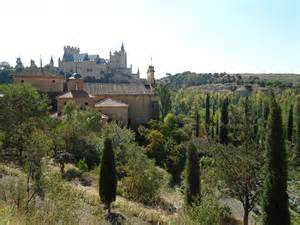The monastery is in the foreground, Segovia behind it in the near distance.
The entrance to the monastery and main chapel
The side chapel in which John's body is enshrined
The body of the saint is in the box on top of this baroque construction.
When John served as prior at Segovia, he became close friends to a noblewoman, Doña Ana de Peñalosa. She help finance the monastery reconstruction and John wrote one of his great poems, The Living Flame of Love, for her. As the major benefactor of the monastery, Doña Ana had insisted that, contrary to Carmelite custom at the time, all friars who served as superior at Segovia would be buried there, no matter where they died. John died in 1591 at Ubeda and was first buried in the chapel there. Later, at Doña Ana's insistence, his body was returned to Segovia. Only much later after his beatification was the body enshrined in the above casket.
There is an episode in Don Quijote de la Mancha in which Don Qujote encounters a group of friars in the middle of the night. They were bearing with them a small box containing the body of a man considered to be a saint. Many scholars believe this incident is based on the transfer of John's body under cover of darkness. He had been so loved by the people of Ubeda that the friars were afraid they would be attacked if they were discovered taking the body to Segovia. So they dug it up secretly and disappeared into the dark night.
If you ever see the tomb itself, you will notice that the casket looks like it was designed for a child. John, of course, was a small man to begin with. But before the remains were put in the casket, his legs as well as some other parts of the body had been removed to be distributed as relics.




1 comment:
Thanks for the swift update. For me, the tomb exemplifies my favorite saying "more is less".
Roderick
Post a Comment